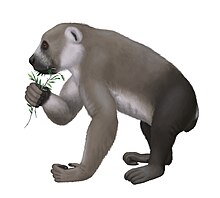Archaeoindris
| Archaeoindris | |
|---|---|

| |
Fossil
| |
| Scientific classification | |
| Kingdom: | |
| Phylum: | |
| Class: | |
| Order: | |
| Suborder: | |
| Family: | |
| Genus: | †Archaeoindris Standing, 1908[1]
|
| Species: | †A. fontoynonti
|
| Binomial name | |
| †Archaeoindris fontoynonti Standing, 1909
| |

| |
| Subfossil sites for Archaeoindris fontoynonti[2] | |
| Synonyms[1] | |
|
Lemuridotherium Standing, 1910 | |
Archaeoindris fontoynonti is an extinct species of Malagasy lemur that was the largest primate to evolve on Madagascar. It weighed about 200 kg (440 lb) and measured around 1.5m in height,[3] more than a silverback gorilla. Archaeoindris is one of eight known members of the Palaeopropithecinae subfamily. Archaeoindris belongs to a lineage of lemurs called "sloth lemurs" because they are built similarly to modern South American tree sloths. Initially, its large body size, and the anatomy of its femur, suggested a similar mode of life to ground sloths, and Archaeoindris was believed to be almost exclusively terrestrial.[4][5] As more fossil material came to light, however, it turned out that its arms and legs were better adapted for slow, ponderous climbing. Phalangeal curvature in primates is correlated with hand and foot function; highly suspensory forms such as the orangutan possess the most curved phalanges. Sloth lemurs, of which Archaeoindris is one, are characterized by very curved proximal phalanges, approaching that of orangutans. However, the data presented in the reference does not include measurements from Archaeoindris, possibly because phalanges had not been recovered at that time.[6]
References
- ^ a b McKenna, MC; Bell, SK (1997). Classification of Mammals: Above the Species Level. Columbia University Press. p. 335. ISBN 0-231-11013-6.
{{cite book}}: Check|isbn=value: checksum (help) - ^ Godfrey, L.R.; Jungers, W.L. (2002). "Chapter 7: Quaternary fossil lemurs". In Hartwig (ed.). The Primate Fossil Record. Cambridge University Press. p. 112. ISBN 978-0521663151.
{{cite book}}: Unknown parameter|editor_first1=ignored (help) - ^ William L. Jungers, Laurie R. Godfrey, Elwyn L. Simons, and Prithijit S. Chatrath (1997-10-28). "Phalangeal curvature and positional behavior in extinct sloth lemurs (Primates, Palaeopropithecidae)". PNAS Proceedings of the National Academy of Sciences of the United States of America. 94 (22): 11998–12001.
{{cite journal}}: External link in|title= - ^ Lamberton C. 1946. Bull Acad Malgache. 27:24–28.
- ^ Jungers W L. 1980. Z Morphol Anthrop. 71:177–186.
- ^ Jungers W.L. et al 1997. Phalangeal curvature and positional behavior in extinct sloth lemurs (Primates, Palaeopropithecidae). PNAS 94, p11998–12001.
External links
